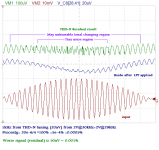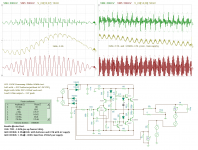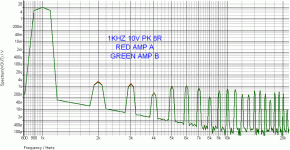This THD+N from 29kHz+30kHz in va290. Well.. The loudspeaker seems really moving in 1kHz path, and 1kHz is not present at the input.
VA290 is only VAS stage and has less than 0.0001%THD @1khz (and may better than any VAS). Also simulation has best supplies. Dunno what really happen when real power amp has 1% or 5% of this IMD (that caused by vary of amplitude) is present.
Thanks anyway for this test.
VA290 is only VAS stage and has less than 0.0001%THD @1khz (and may better than any VAS). Also simulation has best supplies. Dunno what really happen when real power amp has 1% or 5% of this IMD (that caused by vary of amplitude) is present.
Thanks anyway for this test.
Attachments
In any thread, close to interrelation between standard measurements and listenable effects, we all repeatedly go along the same endless circle. One side of this circle is hold be "pure engineers", who deeply sure that passband and phase measurements explain everything, and the other half of the circle is kept by those who really find disrepancies between what they hear and measure. As for me, the last group, at least some representatives, are inclined to deep research and makes some progress, in suggesting new distortions metrics, in doing ultra-low-noise measurements, etc.
I find it not constructive to convince permanently, that standard knowledge in electronics is capable to explain everything in standard well-known terms, and this definitely does not encourage for deeper researches.
By the way, there is curious point in the title of this thread, what tiny effects can happen under fast transient conditions, what requirements to PS are imposed by this? Does PSRR mechanism works infinitely fast, or it has some drawbacks, under transient conditions? Why shunt-like PS better deals with transients? Which level of modulation of PS rail is listenable? Do software simulation tools include all parameters, affecting transients in a real equipment component?
Since effects of individual resistors and connectors are listenable, I guess requiements to PS pulse response must be very rigorous.
I find it not constructive to convince permanently, that standard knowledge in electronics is capable to explain everything in standard well-known terms, and this definitely does not encourage for deeper researches.
By the way, there is curious point in the title of this thread, what tiny effects can happen under fast transient conditions, what requirements to PS are imposed by this? Does PSRR mechanism works infinitely fast, or it has some drawbacks, under transient conditions? Why shunt-like PS better deals with transients? Which level of modulation of PS rail is listenable? Do software simulation tools include all parameters, affecting transients in a real equipment component?
Since effects of individual resistors and connectors are listenable, I guess requiements to PS pulse response must be very rigorous.
Last edited:
I agree that it is not channel separation. Studies were done by the BBC according to Self that showed a perfect stereophonic image could be reconstructed with as little as 20dB separation. However, it may well be that bad separation in modern designs is symptomatic of other issues like PSU cross coupling, PSU supply line conducted artifacts and so on (I am postulating here. Please do not crucify me- just a theory!). This types of distortion in turn may affect the sound stage.
Make no mistake, sound stage in my view is absolutely paramount. On my web site I recount an experience I had in Japan in Yodabashi with a Denon MOSFET amp and a pair of Tannoy's with astounding imaging - both in terms of width and depth.
Certainly, I later came to learn, the Tannoy's are noted for their imaging ability, and, the recording plays a critical part. But, there is general consensus that there is a significant spread in imaging across amplifiers. Putting the recording and the speakers to one side, what the hell is it in amplifiers that bestows imaging performance?
Make no mistake, sound stage in my view is absolutely paramount. On my web site I recount an experience I had in Japan in Yodabashi with a Denon MOSFET amp and a pair of Tannoy's with astounding imaging - both in terms of width and depth.
Certainly, I later came to learn, the Tannoy's are noted for their imaging ability, and, the recording plays a critical part. But, there is general consensus that there is a significant spread in imaging across amplifiers. Putting the recording and the speakers to one side, what the hell is it in amplifiers that bestows imaging performance?
Last edited:
i believe that IMD could be the key... firstly because it seems to be present in large amounts also in low distortion designs, secondly because it happens with multi tone and more music like signals. and not with single test signal...and thus is IMD a much more usable parameter to evaluate performance of a given design than looking at low percentage numbers..and at leat to me it seems hat large amounts of feedback does not seem to improve the IMD figures...
i believe that IMD could be the key... firstly because it seems to be present in large amounts also in low distortion designs, secondly because it happens with multi tone and more music like signals. and not with single test signal...and thus is IMD a much more usable parameter to evaluate performance of a given design than looking at low percentage numbers..and at leat to me it seems hat large amounts of feedback does not seem to improve the IMD figures...
Along the line of your thinking, I would remember the old work of John Curl, Matti Otala and others, about measurements of transient intermodulation distortions. Input test signal was a mixture of definite square wave and sine signals.
I would try to measure and form a database of even more simple measurements - by trying to find correlation of listening tests with PS pulse responce.
Last edited:
Good question, Bonsai.
I agree emphatically with Vladimir.
I have found no correlation between measurements and imaging performance. It is a conundrum. I do know something of how to ensure it in an amp, but it's very elusive and difficult to achieve. Topology and feedback regime are pivotal, I believe.
These threads achieve nothing except to isolate the two schools of thought even more. Who needs the brain damage?
Hugh
I agree emphatically with Vladimir.
I have found no correlation between measurements and imaging performance. It is a conundrum. I do know something of how to ensure it in an amp, but it's very elusive and difficult to achieve. Topology and feedback regime are pivotal, I believe.
These threads achieve nothing except to isolate the two schools of thought even more. Who needs the brain damage?
Hugh
but why not follow that up as the ideas evolved, were tested, extended by Cordell, Campbell, Cherry, Jung, Leach... all of whom demonstrated or came to believe that "low TIM" design had nothing to do with restricting feedback factor - low TIM designs can use high feedback, achieve low distortion numbers, very high feedback amplifiers manage low distortion on complex multitone tests of IMD
no one to date has to my knowledge demonstrated TIM/PID distortion as being in any way audibly special compared to any other IMD distortion in published peer reviewed controlled tests
and its hardly like psychoacoustic researchers wouldn't welcome another "probe" into the complexity of human hearing that a "anomalous" TIM/PID sensitivity would represent
no one to date has to my knowledge demonstrated TIM/PID distortion as being in any way audibly special compared to any other IMD distortion in published peer reviewed controlled tests
and its hardly like psychoacoustic researchers wouldn't welcome another "probe" into the complexity of human hearing that a "anomalous" TIM/PID sensitivity would represent
Let us consider a situation, in the same amp we change something with PS arrangement, from serial to shunt or alike, and all experts report definite changes in listening impressions.
Are we sure that any standard measured parameters will noticably change, including TIM and DIM? Most probably not. And "pure engineers" will state, that listenable effects are not possible, and all experts report bull...
Other persons could conclude, that another measurement approaches should be designed and used, since experts simply report their "measurements", being done by extremely complicated "hearing-brain instrument".
Are we sure that any standard measured parameters will noticably change, including TIM and DIM? Most probably not. And "pure engineers" will state, that listenable effects are not possible, and all experts report bull...
Other persons could conclude, that another measurement approaches should be designed and used, since experts simply report their "measurements", being done by extremely complicated "hearing-brain instrument".
Let's see it from a different angle. The stronger feedback, the more troubles you have to assure perfect stability of the amplifier into complex load. You have to use output coil, bigger output coil, or slow down the circuit. With moderate feedback, I can quite easily achieve 120V/us with no need of the output coil. If I added another 20 dB to feedback, what would I get? Lower distortion by 2nd and 3rd harmonics. As it was about 0.01% before, I do not need it. Higher harmonics above 7th would probably rise. To get the same ultimate stability, I would either need to add the output coil or to reduce slew rate by adding or increasing dominant pole caps or similar means of compensation. No thanks.
no one to date has to my knowledge demonstrated TIM/PID distortion as being in any way audibly special compared to any other IMD distortion in published peer reviewed controlled tests
The same for the THD race, as THD is the main goal of those who vote for the strongest feedback. There is no evidence that it is needed. No difference.
For stereo imaging, a little bit of HF crosstalk seems beneficial :
I can improve the FRANCINSTIEN
I can improve the FRANCINSTIEN
An externally hosted image should be here but it was not working when we last tested it.
Interesting, and what about this Your claim?The same for the THD race, as THD is the main goal of those who vote for the strongest feedback. There is no evidence that it is needed. No difference.
http://www.diyaudio.com/forums/anal...rch-preamplifier-part-ii-827.html#post2415329
THD and IMD is caused by the same circuit nonlinearity. Sometimes audible, sometimes not?
Low TDH (IMD..) is also achievable with moderate feedback , with as good as possible linearity before (global)feedback.
Last edited:
i believe that IMD could be the key... firstly because it seems to be present in large amounts also in low distortion designs, secondly because it happens with multi tone and more music like signals. and not with single test signal...and thus is IMD a much more usable parameter to evaluate performance of a given design than looking at low percentage numbers..and at leat to me it seems hat large amounts of feedback does not seem to improve the IMD figures...
This is not really correct. Anything that lowers THD also lowers IMD. Your assumption that "IMD [....] seems to be present in large amounts also in low distortion designs" is simply wrong. It has been shown again and again that if you have high THD you also have high IMD and vice versa. The correspondence is not exactly 1:1 because they are measured in different ways, but they are caused by the same non-linearities.
jan didden
Here sims result of complete amplifier with both battery supply and AC supply.
This one has low feedback and its sounds warm but little noisy (distorted).
There is a way to combine strong feedback with no feedback, then strong feedback still could be used without damaging Imaging?, Sound stage? Without makes bad fatigues on ears. Any way, what people wanted isn't just same, but closest as real sound as possible is one acceptable goal.
This one has low feedback and its sounds warm but little noisy (distorted).
There is a way to combine strong feedback with no feedback, then strong feedback still could be used without damaging Imaging?, Sound stage? Without makes bad fatigues on ears. Any way, what people wanted isn't just same, but closest as real sound as possible is one acceptable goal.
Attachments
what exactly is the mechanisms behind inter modulation...distortions...??
seems to get quite different results with two tone analysis.. and amplifiers that are good in terms of low distortion also at high amplitudes does not really give the best IMD figures...And for sure the IMD is vastly higher than the normally measured distortions...Eg the Fetsilla with 19-20KHZ test tone has an IMD 1KHz tone at app 2%... and my own design which boasts a 100 times lower distortion and traditionally much better distortion profile has a whooping 4.7%
could be that IMD is the key....as it seems to be significantly higher distortion levels present in multi frequency signals than in single tone steady state...ques that this is a much better measure for what is going on when the amplifier deals with more complex music signals..
The best of my amplifiers boasts an IMD of just 0.7%...compared to single tone distortion of 0.00006% at the same levels..and the goldmund clone that was worked on in this forum is at app 0.8 %...also with very low single tone distortion...
I did an experiment with diodes in output stage making it none switching,,, while the distortion dropped a magnitude the IMD shot up to more than 5 %
Hmmm puzzeled...
You should now try using real equipment to measure instead of the simulator, you going to find some pleasant surprises.
But, there is general consensus that there is a significant spread in imaging across amplifiers. Putting the recording and the speakers to one side, what the hell is it in amplifiers that bestows imaging performance?
Really? There is a general consensus? Can you point me toward any actual data to support any effect of amplification on image and soundstage (beyond separation and crosstalk, which I agree don't have to be spectacular)?
There are circuitry to make stereo wider, one example is Stereo Width Controllers.
Could be that some amps have somothing in its behavior that make a stereo image wider, but it does not mean it is better amp, just opposite.
Could be that some amps have somothing in its behavior that make a stereo image wider, but it does not mean it is better amp, just opposite.
Can you show us a comparison of 1khz THD between the 2 amps?
THD at 1 khz seems almost the same.
Thank to DF96 and Magnoman for tries of explanations, as for accurate ones,
i have none myself that i think is reliably good.
Anyway, i enjoy the debate in this thread, even Wuyit s die hardism
in promoting audio myths...
Attachments
Member
Joined 2009
Paid Member
Why shunt-like PS better deals with transients? Which level of modulation of PS rail is listenable?
I like the idea of shunt regulators - perhaps I look at them from an unusual perspective - I see them as 'perfect capacitors' serving to decouple the power rails without producing audible distortion that electrolytics are well known for. In other words, power rail caps do affect the sound and the use of a shunt regulator takes this out of the circuit. The primary effect is at low frequencies, where capacitors are most limited by rising impedance and because as the ac voltage across the capacitor increases the harmonic distortion produced grows very quickly.
Last edited:
- Status
- This old topic is closed. If you want to reopen this topic, contact a moderator using the "Report Post" button.
- Home
- Amplifiers
- Solid State
- Feedback affects Soundstage, Imaging, Transients ?


